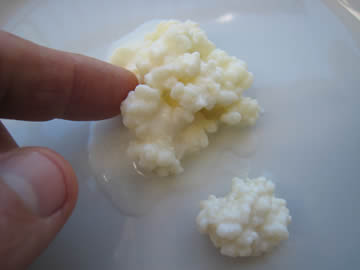
Milk kefir - probiotic living food for long-life
Milk kefir versus water kefir
What is kefir?
Recipe - How to make kefir
What kind of milk to use?
Kefir cheese and whey
Secondary Fermentation
Kefir Grains
Bacteria and yeasts in milk kefir
Buy a milk kefir starter (USA supplier)
Buy a milk kefir starter (Australia only)
Fermentation accessories (Australia only)
References
Milk kefir versus water kefir

Water kefir is described on a separate page. It is a highly nutritious probiotic drink made from a variety of sugars and water. It is particularly valuable for those who want a non-dairy probiotic.
Do NOT dismiss water kefir because it contains sugars, and may be high in sugar. It contains and promotes bacteria that eat sugars, and therefore need to live in a sugar medium. Water kefir heals candida, and is suitable for diabetics in small quantities provided they monitor their blood sugar level. The numerous benefits of water kefir are too significant to ignore.
What is kefir?
Milk kefir is a refreshing, probiotic cultured milk drink that originated in the northern Caucasus Mountains many centuries ago. Kefir means "feel good" in Turkish. It has a thick creamy sticky consistency, tastes a little like yogurt, and has a milky, yeasty smell. After a few days in the same container, the smell can become very sharp and cheesy, but it is NOT putrid. Many aromatic compounds contribute to its unique flavour and distinctive pleasant aroma. Kefir has a slight natural carbonated effervescence, and contains between 0.08 - 2 % alcohol.
Kefir is unlike most other dairy products because it is easily digestible and contains little sugar (lactose), especially if you let it ferment for a longer period. The proteins in the milk are also broken down, and are virtually in a pre-digested state. I drink it on its own, as a meal in itself, and a source of protein. Some people combine it with fruit or muesli, or use it to make a smoothie. The whey makes a great starter for sourdough breads, cakes, and all forms of baking. If, like most people, you have a damaged digestive system, a glass of kefir is a magic soothing and healing product. You may find that during the hours after drinking it, your stomach feels settled and stable.
Unlike yogurt, kefir contains around thirty strains of bacteria and yeast, mostly including Lactobacillus bacteria. The culture comes in little translucent balls called grains, though these grains have nothing to do with any kind of cereal. They are a complex bio-matrix structure of soluble gel-polysaccharide, organic acids, yeasts and bacteria. This polysaccharide called Kefiran is made from two mono-saccharides, glucose and galactose in almost equal proportions. Kefiran has anti-tumour properties, preventing the development of metastasis. It is an anti-inflammatory and is an excellent stimulant for your immune system. The grains produce their own antibiotics. Kefir is rich in minerals and vitamins, particularly the B group, and vitamin K2. Kefir slows the aging process and has many healing properties, helping with heart and artery disease, improving cholesterol levels and regulating hypertension / blood pressure. It assists your digestive system, healing the liver, kidneys, spleen, pancreas, gallbladder and stomach ulcers, and soothing your digestive and urinary tracts.
Recipe - How to make milk kefir
How to make kefir: put 1-2 tablespoons of milk kefir grains in 1 cup (250 ml) of milk, and leave it to ferment for 12-48 hours at a temperature of 18-30C. It needs a longer period with less kefir grains or lower temperatures. At first the milk thickens, then it starts to set. Next, it separates into curds and whey. You can eat it at whatever stage you like.
When your kefir is ready, remove the grains with a fork and use them to make your next brew.
If you do not want to make another brew immediately, you can store the grains in milk in your refrigerator. I have done this for a month, and after starting to use them again I found they had lost their vitality. The first brew took several times longer than normal, and it took several more brews before the grains were back to normal.
If you freeze the grains, you will probably destroy them.
Do not keep your kefir in a metal container like copper, iron or aluminium. Preferably store it in a glass or ceramic container.
There is no need to wash the kefir grains between each brew - this may even damage them. However, it is good practice to give the grains a 'rest' in filtered water once every few months. This rest can be 12-24 hours, and the water produced is a nourishing drink.
What kind of milk to use?
Traditionally kefir is made with raw, un-homogenised, full-fat (full cream) milk, and that is what makes the best kefir. Kefir made with milk straight from the animal and not tampered with, is by far the most nutritious and digestible.
You can also make kefir with pasteurised, homogenised, high-calcium or low-fat milks, and even cream. Most people buy their milk at a supermarket, so it is difficult to avoid pasteurised milk. But if you can, try to buy full cream, un-homogenised, permeate-free milk with nothing else (such as calcium) added or removed. There are good reasons for always using such milk, as detailed in Grow Youthful.
If you use cheap supermarket milk to which permeate has been added, the permeate tends to separate in the kefir and the result is more like cottage cheese with liquid whey, rather than a creamy kefir.
I have even made kefir with whey powder mixed with water (not recommended from a health point-of-view of course, but just to prove that it can be done).
You can make kefir with nut milks or coconut milk, and nut kefir is delicious. However the nut milk destroys the kefir grains, so you can only make it when you have got some spare grains.
Kefir cheese and whey
If you leave the kefir for a day or two it will start to clabber - the cheesy creamy looking curds start to separate from the clear whey. If you plan to separate them, don't stir or shake them for a day. Line a large funnel, plastic sieve or colander with a thin cloth, and gently pour in the mixture. Let the whey gently drip into a container - it can take 24 hours or more. Do not try to squeeze out the cloth or speed the process, or the whey will be cloudy. You can use the curds as a cream or cottage cheese. The whey will store in the refrigerator for many weeks, and has many amazing healing properties (see the Grow Youthful ebook).
Secondary Fermentation
This is the traditional or 'no-fridge' method of storing kefir. It is by far the healthiest way to consume kefir, because most of the sugars have been fermented, especially the harmful galactose. (1) You can bottle the liquid and store it at room temperature for up to one week. This will cause secondary fermentation, and the kefir will be sour and fizzy. It will have higher levels of folate, alcohol (but less than 2%) and B group vitamins. The secondary fermentation will consume most of the remaining lactose in the kefir, making it suitable for lactose intolerant people, or those who need to watch their sugar intake (e.g. Diabetics). The longer you leave it, the sourer its taste. Fill the bottle only 3/4 full. Release the build-up of CO2 gas daily, and give the bottle a gentle shake at least once a day. The agitation is necessary to mix the yeast colonies back into the kefir and minimise the chances of mould developing. You can pour out kefir to use at any time, or top it up with fresh kefir made that day - as an ongoing storage method.
Kefir Grains
The milk kefir grains vary in size from the size of this 0 to that of an egg. They look like a piece of translucent cauliflower or cottage cheese. Between the fingers they feel squishy, kind of slimy, and rubbery in texture. Milk kefir grains are quite chewy and tough. They can take from days to weeks to double in size. They are also highly nutritious to eat - that is where the Kefiran is concentrated.
Some suppliers on the web sell dry kefir starters, dry kefir grains, or powder to produce kefir. None of them are the real thing. It is important to get living kefir grains which reproduce and grow, and have the FULL range of bacteria and yeasts.
Get kefir starter grains from a friend, or
buy milk kefir grains if you live outside Australia (USA supplier)
buy milk kefir grains if you live in Australia.
Bacteria and yeasts typically found in milk kefir
Bacteria:
Lactobacillus.
L. brevis has been identified as the species responsible for the production of the polysaccharide (dextran) that forms the grains.
L. casei. Produces lots of lactic acid; colonises well in the gastric tract; creates a favourable medium in which other beneficial bacteria can grow; inhibits putrefaction and harmful bacteria; increases immune function; helps protect against bacterial infections.
L. hilgardii.
L. plantarum. Produces lactic acid; fights listeria monocytogenes; makes plantaricin; inhibits a large number of Gram-positive bacteria - the type of bacteria that cause spoilage.
Streptococcus.
S. cremoris. Has similar properties to S. lactis.
S. diacetylactis. Produces carbon dioxide in the kefir; makes diacetyl, which gives kefir its characteristic odour; other properties similar to S. lactis.
S. lactis. Produces lactic acid, aids digestion, inhibits harmful microorganisms, produces bacteriolysins.
Pediococcus.
Leuconostoc.
Yeasts:
Saccharomyces.
Candida.
Kloeckera and possibly others.
Buy milk kefir grains if you live outside Australia (USA supplier)
Buy milk kefir grains if you live in Australia
References
1. Both bacteria and yeasts have a preference for glucose (rather than other more complex sugars) as their food source. When glucose is available, these microbes actually shut down their production of the enzymes that digest other sugars. When all the glucose is used up, it is only then that they start to digest lactose, galactose and fructose.
Albert G. Moat, John W. Foster and Michael P. Spector.
Metabolism Of Substrates Other Than Glucose.
Microbial Physiology. 2002 by Wiley-Liss, Inc. ISBN: 0-471-39483-1.
